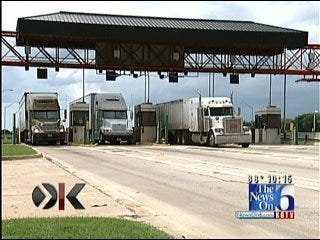Oklahoma Turnpikes: Was The Last Toll Increase Really Necessary?
When the Oklahoma Turnpike Authority raised tolls on all the state's turnpikes by more than 15 percent last year they claimed it was because of a budget shortfall. But they may have passed the bill on to their customers when they had plenty of money to make up the shortfall themselves. <br /><br /><a href="http://managekotv.worldnow.com/global/Category.asp?c=192033" target="_self">Interactive Turnpike Timeline</a>Wednesday, July 21st 2010, 11:55 pm
By Jennifer Loren, The Oklahoma Impact Team
OKLAHOMA CITY -- Last year the Oklahoma Turnpike Authority raised tolls on all the state's turnpikes by more than 15 percent. The authority claimed a budget shortfall forced them to do it. But the Turnpike Authority may have passed the bill on to their customers when they had plenty of money to make up the shortfall themselves.
Last summer the economy was tanking and traffic was lagging on all of Oklahoma's turnpikes. The biggest problem was with truck traffic. According to the Oklahoma Turnpike Authority truck traffic was down about 15 percent from 2008. This trend was projected to continue through 2009, leaving the Turnpike Authority with an estimated $21 million shortfall in toll revenue. Administrators say they were forced to cut back on road rehab and maintenance projects and were worried they wouldn't be able to make their debt payments.
"We couldn't sustain that ongoing without finding a way to increase revenues," said Tim Stewart, the Deputy Director of the Oklahoma Turnpike Authority.
To bring in the needed cash the Turnpike Authority's board voted yes to a statewide toll increase, leaving many Oklahoma drivers frustrated.
"With the economy right now I just felt like it wasn't a very good time," Edmond citizen, Kellie Glass, argued at the turnpikes board meeting where the toll hike was approved.
But turnpike administrators claimed it was a necessary evil.
"It's a bad time to have to increase somebody's cost of transportation and we wouldn't do it if we didn't have to do it," said Phil Tomlinson with the Turnpike Authority.
But at that time, we learned the turnpike authority had $260 million in its cash account. According to turnpike administrators, that money could not be touched. Here's how it was being spent:
• The largest portion, about $88 million, was a contractually-required cash reserve to ensure the authority could pay it's billion dollar debt.
• $43 million are in a motor fuel tax trust fund that must be held there according to law.
• There were $9 million in the reserve maintenance account for upkeep on the highways and bridges.
• $20 million in prepaid tolls as part of the Pikepass system.
• Plus another $15 million in the checking account for ongoing expenses, including payroll.
• But the rest, $85 million, was uncommitted general funds which can be used for anything the authority wants.
Administrators say that $85 million is set aside as a safety net, in case of an emergency like a bridge collapse, where the turnpike authority would face a sudden and unexpected expense and loss of toll revenue.
"We don't have business interruption insurance. So if we don't collect tolls we just don't get the money because we don't receive state or federal appropriations," said Stewart.
But, compare that fund with the state's rainy day fund which plays a similar role. It's capped at 10 percent of the prior year's revenue. If the turnpike authority played by the state's rules, their account would contain just $20 million. But turnpike administrators insist their safety-net could not be touched and slashing their own budgets would not have worked.
"If we'd of done that our customers, the system in total would have substantially suffered," said Stewart.
Stewart says the authority did cut some operating costs, minimized highway rehab projects and shrunk what was reinvested into the system. But, unlike state agencies, they were not forced into layoffs.
In August 2009 the toll increase took affect. On the Turner, for example, tolls climbed to $4 each-way for cars and up to $20 each-way for semis.
"I'm still going to have to take the turnpike, I'm still going to have to use it so I'm going to have to pay it so it's kind of frustrating yeah, and disappointing," said one driver.
But now, not even one year later, the Turnpike Authority's board gets good news. Traffic on the turnpikes is actually increasing.
So this is the third month in a row that we have seen heavy truck traffic improve," reported Wendy Smith at a recent Oklahoma Turnpike Authority board meeting.
Increased traffic is bringing in even more toll revenue than projected… $2 million more so far this year.
When asked if the tolls could go back down if traffic continues to increase, board members said it wasn't likely.
"That's always a possibility. However we have expansion issues also in the Creek Turnpike and the Kilpatrick Turnpike and the Turner Turnpike going from four lanes to six lanes," said Doug Riebel, OTA Board Chairman.
Those are more projects that require more money. However it's not been decided where the money for those particular projects will come from.
The Turnpike Authority is using funding from the toll increase right now to pay for what it says are long overdue rehab and maintenance projects, including a $10.4 million renovation of the Glass House McDonalds over the Will Rogers Turnpike.
Visit our interactive timeline, Oklahoma Turnpikes: An Historical Road Map, where you can track all of the major decisions about our turnpikes since the very beginning.
More Like This
July 21st, 2010
September 29th, 2024
September 17th, 2024
Top Headlines
December 14th, 2024
December 14th, 2024
December 14th, 2024
December 14th, 2024













